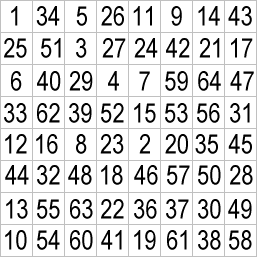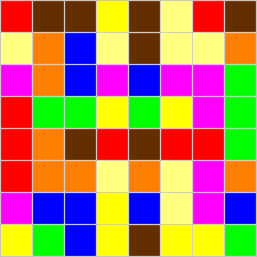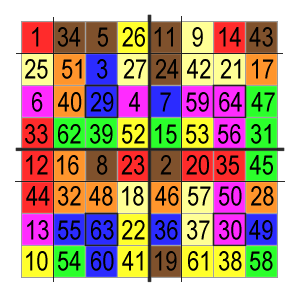Press and hold the mouse button anywhere on or around the cube, and it will start rotating towards the cursor.
You can also press and hold the mouse button on the little red squares to modify the Perspective and Transparency ( Alpha ) of the cubes.
If you enable Autorotate, then the cube will continue to rotate in the direction you last told it to with the mouse.
There are a couple buttons at the bottom that will orientate the cube left or right.
Finally if you want to reset the cube to its original rotation, hit the reset button.
The ‘standard layout’ for the numbers of the hexagrams of the I Ching is -
This seemingly random (chaotic?) group of numbers changes when the 8x8 square is divided into four quadrants - Q1, Q11, Q2, Q12 - 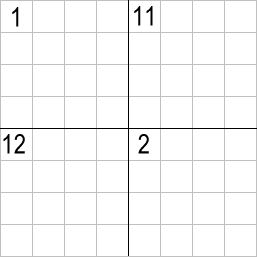
Looking for other patterns, you notice that Q1 has six pairs of numbers and four single unmatched - 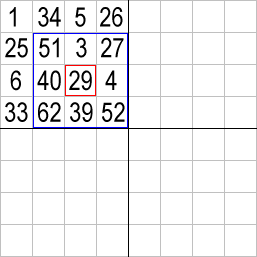
There is nothing similar in Q11 and Q12. But in Q2 - 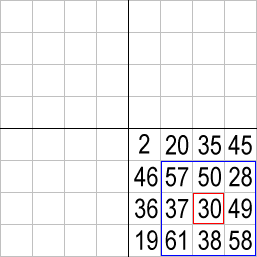
- an almost identical pattern of six pairs with four unmatched - but the unmatched in Q2, match the unmatched in Q1. Q1 and Q2 are numerically independent from Q3 and Q4. Looking now at Q11 and Q12, you find a pattern pretty much the same as for Q1 & Q2 - 
- pretty much the same, but not too much the same - where Q1/Q2 are connected thru four numbers, every number in Q11 has its partner in Q12. Note that the central numbers of the group of 9 in Q1 & Q2 are 29 and 30 - the last numbers of the First Book of the I Ching; and the central numbers of the group of 9 in Q11 & Q12 are 63 and 64 - the last numbers of the Second Book. It gets a bit like looking thru a kaleidoscope. Each house in the I Ching has eight hexagrams. To simplify matters, I have given a colour and number to each - on the right of the following chart -
The first four houses are usually referred to as the houses of Heaven (H); houses 5 to 8, as the houses of Earth (E). Colour dia. 1 accordingly and you get -
The simplest pattern is that red squares mirrored are by green; orange by purple; blue by cream; and brown by yellow. Eight houses, four patterns. If you ‘cut’ the table in half, horizontally or vertically, turn any half upside down and you find that all squares are matched - red to green etc. etc., as above. Contrary to this red/green match, the I Ching says the houses of Heaven (H) and Earth (E) determine the direction; the forces of Mountain (M) and Lake (L) are united; Thunder (T) and Wind (W) arouse one another; Rain (R) and Fire (F) do not combat each other. From this, place Q1 on top of Q2, and Q11 on top of Q12. The houses perfectly match one another . I referred above to numbers 29/30, 63/64 - we can now see each pair consists of Rain and Fire. Also each pair in Q11/12 consists of one H one E house, but not so with Q1/Q2 where, for example, 51 & 52 are both H houses. If you scan the diagonals left to right, descending from top left to bottom left, then across to bottom right, you find that each diagonal has one, then two, then three different houses - up to eight, bottom left corner - then back to one, at bottom right. In diagonals running right to left, this pattern does not occur. Scan the columns and you find in each of them two H houses and two E - mutually exclusive groups -
Bizarre? If you allocate the numbers as per p3, you get
Both columns total 18. ‘Skipping’ diagonally, you get 1, 3, 6, 8 and 2, 4, 5, 7 - both of which total 18. Add 1 + 8 = 9. If you haven’t considered it yet, adding the numbers from one to eight (for the eight houses of the I Ching), you get a total of 36. Add 3 + 6 = 9. I introduce this here because number 9 pops up all over the shop. You look for patterns, you find them everywhere. Strip Dia. 2 to - 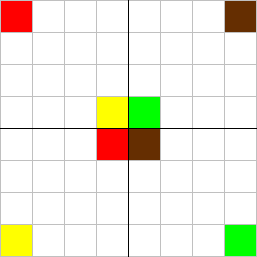
The four corner squares and the four centre squares match – given a flip and a nudge. Looking at it, I feel as if the outer ‘ring’ is turning clockwise and the inner anti-clockwise - a sort of flow and counter-flow – like when you look at the blades of a fan spinning overhead. Develop the corners, and you get - 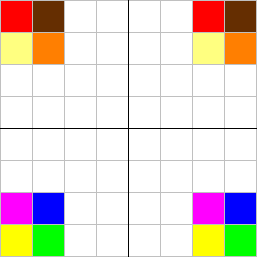
Take each group, flip from left to right, place them in the 16 centre squares, and - 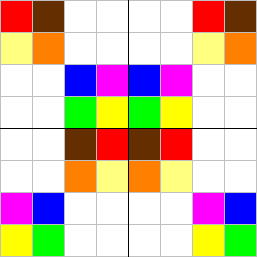
- thirty two squares covered by two patterns. Fill the empty top right corner of Q1, flip from top to bottom, it becomes the bottom left corner of Q2. 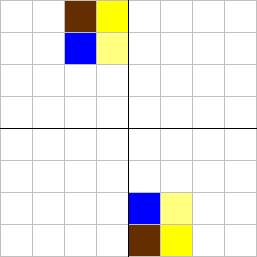
Likewise, the bottom left corner of Q1 becomes the top right corner of Q2. 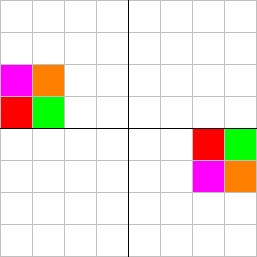
What remains is four opposing/balanced groups of E and H forces - 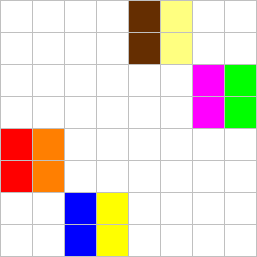
Put them all together again, you are back with -
Deconstruct the whole thing, you get - 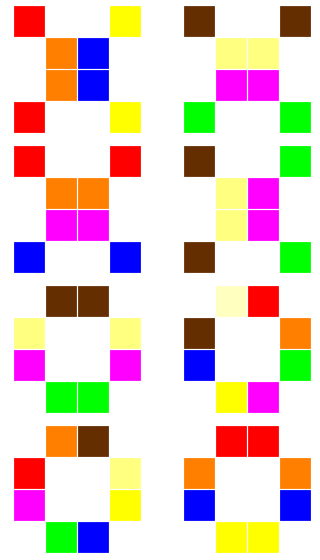
I have dubbed the top 4 pattern Alpha, the bottom 4 pattern Omega - I could try Yin/Yang, Female/Male, Open/Closed, etc. - but I get the feeling each is the other. So - Alpha 1 & 12 consist of 4x2 H houses; Alpha 2 & 11, 4x2 E houses. Twist Alpha 1, to the right, you get Alpha 12; twist Alpha 11 to the left, you get Alpha 2. (Somewhere in the I Ching it says that Heaven turns to the right, Earth to the left.) If you look at Omega 1, we have 4x2 E houses; Omega 2, 4x2 H houses. If you expand/contract Omega 1, you get Alpha 11; if you expand/contract Omega 2 you get Alpha 12. Omega 11 & 12 consist of 4x1 H houses, and 4x1 E houses. With Omega 12 - if you twist the H houses to the right and the E houses to the left - you have Omega 11 - and what was adjacent in Omega 12 is opposite in Omega 11. These two patterns, Alpha/Omega (Yin/Yang) are completely basic. Turn all numbers of Dia.1 into H or E, as per page 3, and the layout becomes -
The top four lines have 5E to 3H; the bottom four 5H to 3E. Scanning the columns from left to right, the first four have 5H to 3E, the second four 5E to 3H. Q1 and Q2 mirror one another, to a pattern of 8H/8E. Q3 and Q4 also ‘mirror’ one another, but the groupings are 12E/4H and 12H/4E.
When you mark out the pairs of numbers, 1/64, together with their houses, as above, you get -
We see that H is an odd number four times (with E - 1, 23, 33; with R - 35); and four times an even number (with E - 12, 20 44; with F - 14). For all houses we have - 
The total of odd numbers in the H group is 15; in the E group, 17. With the even numbers the pattern is reversed - H 17, E 15. More important is the ‘pairing’ of W and L. While all other houses have two odd, two even ‘partners’, W has three odd, and L has one. Earth is where we find confusion? The I Ching refers to ‘confusion’ as ‘disturbed equilibrium’. But it also acknowledges that this ‘disturbed equilibrium’ is necessary. Every now and then, like here, examples appear. Besides a number and a colour, each house is associated with a particular point on the compass (here, the Sequence of Earlier Heaven) -
Replace houses with compass points and what was hidden becomes visible - 
- cardinal compass points are paired only with other cardinal points; secondary points with secondary points - including the ‘disturbed’ pairings of Wind and Fire. It seems there is nothing at all random about the ‘standard layout’ - I assume the few instances of ‘disturbed equilibrium’ which do occur, such as the pairings of Wind (SW) and Lake (SE), are absolutely deliberate, an essential part of some overall pattern - if there were no ‘disturbance’ the layout would be stable/static - a notion completely at odds with the I Ching – “Rest is merely a state of polarity that always posits movement as its complement.- We would have entropy. In the following diagram, ‘stars’ indicate the location of the ‘odd numbers’ in the standard layout. 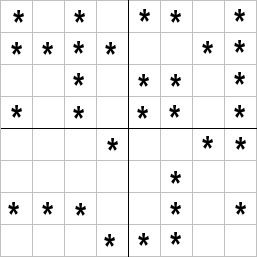
I see no visual pattern - tho’ I can easily imagine one or two staring me. But there is a numeric pattern - Q12 has five odd numbers, Q2 has seven, Q1 has nine, and Q11 has eleven. Add the diagonals and you total 16 = 1+6 = 7 Gazing at it, I can imagine I am looking at an ancient sky chart - here, the Big Dipper; there, the North Star. Maybe somewhere a buried treasure - an unknown planet? The following patterns emerge when we turn the standard layout into a series of rings - or as a spiral -going from the outer to the inner. Ring 1 has twenty-eight squares (4x7); ring 2 has twenty (4x5); ring 3 twelve (4x3); ring four, (4x1). Going clockwise from top left, spiralling in to the centre, the following is the result - 
The letters H, E, L, etc refer to the houses. Scan the columns, you have again, only four groups - configurations vary, but the same forces are always together. In order of appearance - 
Groups one and four form a pair, groups two and three another pair. The order in which the groups appear within the ‘spiral’ is - 
Crazy? Shuffle the groups a bit and you get - 
Which becomes - 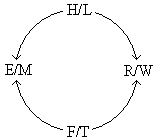
If you refer back to p3, " - red squares are mirrored by green; orange by purple; blue by cream; brown by yellow," - this is what, again, we have. A final reduction? As per p9, each house is associated with a compass point. Introduce them and the above becomes - 
Which is the equivalent of - 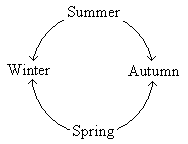
A ‘strange’ one. If you give each house the number assigned on p3, you have - 
Not only does each column total 9 (1+8 = 9), the total of the horizontals is also 9. These patterns only emerge if you start from to left corner and move clockwise. Any other starting point and you have no patterns. A similar pattern emerges if you start from top right and go anti-clockwise. But again, only from that one starting place. In the following, the houses are replaced by their associated numbers - as per p3. 
What is now obvious is that each column, each line, each group 4x7, 4x5, 4x3, 4x1 must total 9 - as must the entire I Ching. 9 holds it all together? 9 is a metaphor for Tao? Return everything to the basic H and E - 
- lines one and three balance; likewise lines two and four - and we see what was not before recognised - each side of the 8x8 panel, from outer to inner, is strictly related/balanced. Seems like an immaculate knot. But two sequences do not occur - HEHE and EHEH. I give again the numbers of the hexagrams of the eight house -
If you replace the eight numbers for each house with a letter - ‘a’ for H1; ‘b’ for H44; etc. Every house with the same letters applied to the above sequence of numbers. Set them out, you get -
Is it from how the elements are arranged that the nature of the houses is determined? Place the 8x8 grids on top of one another, in the sequence H, T, R, etc. and you have - 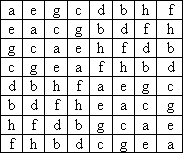
As was shown on p.2, Q1 and Q2 are completely independent from Q11 and Q12 - but now the division is more apparent - Q1 and Q2 are composed of elements aceg, Q11 and Q12 of bdfh. If you look at the top left chart, the H chart, count the number of times a hexagram appears in each column, you have the sequence - 4, 0, 0, 1, 0, 1, 2, 0. Without referring to any other chart, the following pattern can be constructed - 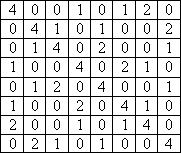
In the long run, maybe it reduces to - 
or - 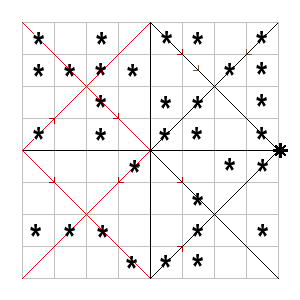
The last transformation comes from unwinding the entire 8x8 grid. The table indicates the number of times each house appears in each group - 4x7, 4x5, 4x3, 4x1. 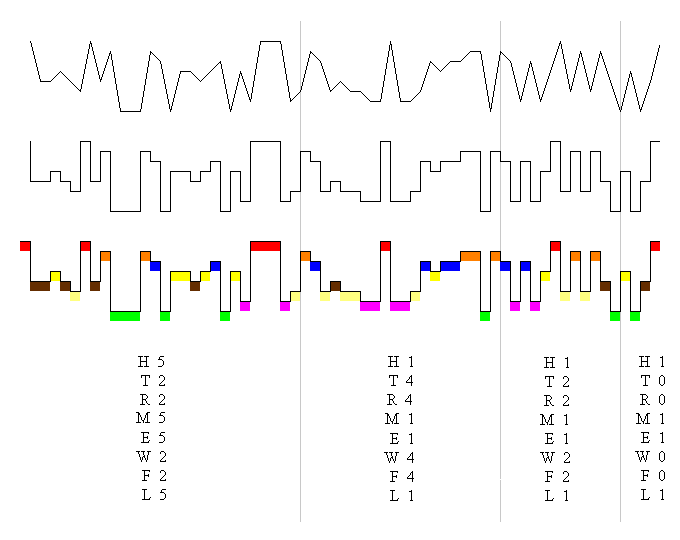
I can easily accept that you lay out one good pattern, and others automatically follow - but so many? - and in such fine detail (the layout of odd numbers; the ‘pairings’ of numbers in the four quadrants)? Did the separation of the hexagrams into lower and upper trigrams inevitably lead to the ‘standard layout’? I can’t imagine so - but can all the above patterns be easily squeezed out of 64 numbers? Hexagram 16, Enthusiasm, says - ‘It furthers one to install helpers -’ I asked a couple of friends to help me. I am indebted to both. One provided shelter, a place to work, a computer. Another is a young computer freak - I talk to him about an 8x8 square, he plays around with an 8x8x8 cube. If you look at dia. 2 as one face of a cube, then a twist and a click, gives you - 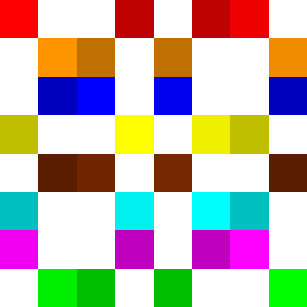
Alphas and Omegas - as I hadn’t seen them before. If you place the hexagrams for each house on a different layer, H1 on layer ‘a’, H44 on layer ‘b’, etc., ‘nothing added, nothing taken away’, give it a click or three and you get - 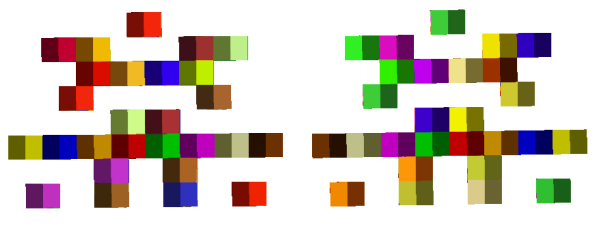
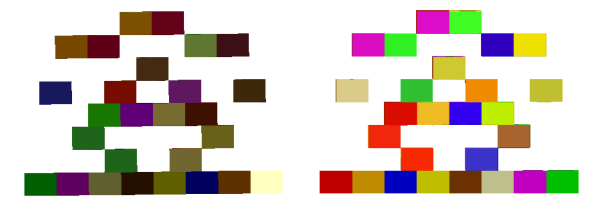
|
||||||||||||||||||||||||||||||||||||||||||||||||||||||||||||||||||||||||||||||||||||||||||||||||||||||||||||||||||||||||||||||||||||||||||||||||||||||||||||||||||||||||||||||||||||||||||||||||||||||||||||||||||||||||||||||||||||||||||||||||||||||||||||||||||||||||||||||||||||||||||||||||||||||||||||||||||||||||||||||||||||||||||||||||||||||||||||||||||||||||||||||||||||||||||||||||||||||||||||||||||||||||||||||||||||||||||||||||||||||||||||||||||||||||||||||||||||||||||||||||||||||||||||||||||||||||||||||||||||||||||||||||||||||||||||||||||||||||||||||||||||||||||||||||||||||||||||||||||||||||||||||||||||||||||||||||||||||||||||||||||||||||||||||||||||||||||||||||||||||||||||||||||||||||||||||||||||||||||||||||||||||||||||||||||||||||||||||
